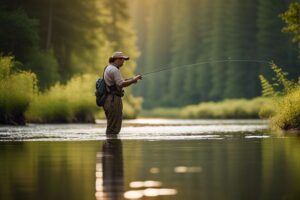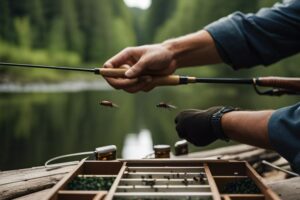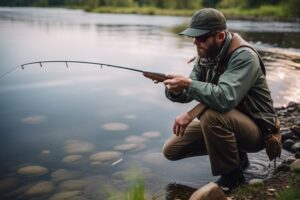With the sun dipping low and shadows stretching across the water, evening presents one of the finest opportunities for fishing with dry flies. As the sky darkens, insects become more active, drawing hungry fish to the surface. You must adjust your approach, using stealth and precision to increase your chances of success. This guide will help you master the techniques needed to effectively fish dry flies during these dimming hours, ensuring you make the most of this magical time on the water.
Choosing the Right Dry Fly
A wise angler knows that the right choice of dry fly can make all the difference, especially in the fading light of evening. As the sun sets, the conditions change and fish often feed more aggressively. To capitalize on this behavior, you must select flies that appeal to their hunger and are suitable for low-light environments.
Selecting Flies for Low-Light Conditions
Selecting the right dry fly for evening fishing requires a keen eye and careful consideration. In low-light conditions, many insects that fish feed on become less visible to both the angler and the fish. Choose patterns that mimic common evening hatches. Look for popular options like beetles, large mayflies, or caddisflies in darker colors, as these can effectively attract attention even as light fades.
Importance of Visibility and Contrast
For your dry flies to be successful as dusk approaches, visibility and contrast become paramount. Fish rely on their vision to locate food, and in lower light, flies that stand out against the water’s surface are more likely to be noticed. Flies with a combination of dark bodies and bright wings or indicators can create a silhouette that catches the attention of lurking fish.
Low-light conditions can make it challenging for you to spot your dry fly, so choosing a pattern that offers high visibility while remaining true to the natural food sources in the water is crucial. Flies that create a substantial silhouette or have a striking color contrast will ensure that both you and the fish can see them even as twilight descends. Aim for flies that not only appeal to the fish’s senses but also remain manageable for you as you cast into the dimming horizon.
Reading the Water
Now, you must tune into the rhythm of the evening water. The magic happens as dusk approaches. Shadows stretch, and the day’s warmth gives way to coolness. Fish begin to feed. This is the time when you need to look closely at the surface. You may spot the telltale rises—small splashes, sips, and the subtle ring of fish breaking through the surface. These signs indicate where fish are feeding, allowing you to hone in on the right spots for your dry flies.
Identifying Evening Feeding Patterns
Reading the water during this golden hour requires patience and observation. Look for subtle movements, as the evening light begins to fade. Fish tend to feed more aggressively when they feel less exposed, and evening brings that cover. Pay attention to insects as well. You may notice mayflies or caddis fluttering above the surface, drawing fish to feed just below the expanse of water. This interplay between light and insect activity is vital for your evening success.
Understanding Water Structure and Currents
Identifying where the fish might hold requires more than just spotting rises. Observe the water’s structure and currents—rocks, eddies, and seams create holding patterns for fish. Fish often seek shelter behind obstacles or in slower currents, where they can conserve energy while waiting for food. Focus on these areas to maximize your chances. Look for foam lines and soft spots; these indicate where food is likely to be concentrated.
Feeding patterns shift with the current. In fast water, fish may lie in breaks or softer pockets where they can ambush their prey. Meanwhile, in slower water, they may roam more freely. By understanding these nuances in water structure, you enhance your ability to read the evening scene accurately. This knowledge will guide your approach, allowing you to place your dry flies in just the right spot where fish feel safe to rise. Stay keen, remain patient, and watch the water closely. Every detail counts as twilight unfolds.
Presentation Techniques
Clearly, presenting a dry fly in the evening requires a keen understanding of the changing conditions. As the sun sets, the light diminishes and the fish become more active, often rising to the surface to feed. Your approach should be subtle and deliberate. Use the fading light to your advantage, ensuring your casts mimic the natural behaviors of insects on or near the water’s surface. The goal is to integrate your fly into the environment seamlessly, so it appears as a natural food source rather than an artificial lure.
Casting in Low Light
Casting in low light demands precision and patience. The nuances of your rod movement are amplified in diminished visibility. You will need to focus intently on your target area without relying on visual cues as heavily as you would in broad daylight. The key is to make your overhead casts smooth and controlled. Approach your casting with a steady rhythm, and anticipate where the fish are likely to rise, casting just beyond that spot.
The Importance of Accurate Placement
Casting accurately becomes imperative during these low-light conditions, where stray casts can spook fish and ruin opportunities. Your dry fly needs to land softly on the water’s surface, as fish are cautiously feeding in the dim light. A well-placed fly can mean the difference between a strike and a missed opportunity. Make use of the contours of the water, such as ripples or pockets, and place your fly strategically to elicit a response.
For instance, understand that fish tend to congregate near structure or in current seams where food is likely to be concentrated. Even in reduced visibility, these spots remain productive. Position your dry fly just upstream of these areas, allowing it to drift naturally into the feeding zone, where it can entice fish to strike.
Varying Retrieval Speeds
One aspect often overlooked in evening fishing is the significance of varying your retrieval speeds. The slow, methodical retrieve can imitate an insect that is struggling on the water’s surface. Conversely, a quicker retrieve can suggest a fleeing insect that might entice a more aggressive strike. Adjust your speed based on the observed behavior of the fish. If they seem cautious, slow down. If they’re actively feeding, speed it up to catch their interest.
Light fluctuates significantly during evening hours, and so will the fish’s feeding habits. Keep an eye on the surface activity, as it will inform you when to change your retrieval speed. Bear in mind, an erratic movement can mimic an injured insect, making it much more appealing to the fish lurking below. Stay adaptable, and let the behavior of the fish guide your technique.
Fly Manipulation
After the sun sets and shadows creep over the water, dry flies can rise to the occasion if you know how to manipulate them effectively. Evening fishing often presents unique opportunities as fish become more active. Understanding how to make your fly appear lifelike or enticing is imperative in drawing the attention of wary trout. In these low-light conditions, subtle movements can provoke strikes when still water may otherwise grow silent.
Creating Movement and Action
An effective way to enhance your chances of success is to create movement and action with your fly. While dead-drifting can be effective, it often helps to vary your retrieval technique. You can achieve this by subtly twitching the rod tip or using short, quick strips to simulate an injured insect on the surface. This mimics the erratic movements of aquatic life, drawing the attention of fish lurking just below the surface.
An additional technique involves varying your presentation by incorporating pause intervals. Giving your fly a moment to rest can increase its appeal. Trout are curious creatures; the sudden stillness followed by a slight twitch may resemble their natural prey’s behavior. The key is to create a rhythm that reflects the dynamics of the ecosystem around you.
Using the Wind to Your Advantage
Manipulation of your fly can also be enhanced by understanding and using wind conditions. Wind can create ripples on the water’s surface, serving as a natural cover for your fly. You can allow the wind to assist in creating movement, letting it drift your fly into the feeding lanes of fish. When a breeze stirs the surface, it helps disguise your presentation, making it less likely that fish will become suspicious of an artificial fly.
Your awareness of wind patterns can help you position yourself and your casting. A gentle crosswind may allow you to achieve a more natural drift, as it moves your fly towards where fish are likely feeding. Remember that movement is imperative. Whether the wind is strong or gentle, adapt your technique to take full advantage of its effects, letting nature guide your presentation as you wait for the inevitable strike.
Dealing with Challenges
Coping with Wind and Water Conditions
To successfully navigate the challenges posed by wind and water conditions while fishing in the evening, you need to choose your location wisely. Seek out sheltered spots where the flow is gentle, and the wind is less intense. Casting is harder when the wind blows against you. Instead, let the breeze help guide your fly. Position yourself downwind of your target area whenever possible. This way, you can maintain better control and make more accurate presentations.
With turbulence on the water surface, visibility is reduced for both you and the fish. Choose brighter or more visible dry flies to cut through the chaos. Flies that create noise or ripple on the surface can attract attention. Bear in mind, fish can be more forgiving in low-light conditions, so don’t be afraid to explore different patterns until you find what works. The goal is to maintain your focus and adapt to the whims of nature around you.
Adapting to Changing Light Conditions
Conditions shift rapidly as the sun sets. You may find yourself faced with diminishing natural light, making it crucial to adjust your technique accordingly. Increase your awareness of the water as your visibility decreases. Fish tend to become more active and rise closer to the surface at dusk, but spotting them requires keen attention and adaptability on your part.
Light levels influence how fish perceive your dry fly. As the environment darkens, opt for darker, bulkier patterns that create more silhouette against the fading light. These flies stand out against the dimming backdrop, drawing fish to your offering. Experiment with different color combinations and designs until you determine what elicits the best response. Always keep in mind that every evening is different, and your ability to adapt will often be the key to your success.
Evening Fly Fishing Strategies
Not many anglers realize the unique opportunities that the low-light conditions of evening provide for dry fly fishing. As the sun sets, the water comes alive with activity. Insects begin to emerge, and fish rise to the surface, ready to feast. This is the perfect time to use the strategies that take advantage of the evening’s magic. To enhance your approach, you might explore advice on Night fishing: choosing the right fly that can guide you in selecting the right patterns for this time of day.
Targeting Specific Species
Species will vary in their feeding habits as evening approaches. Trout, for example, become more active, often rising to take advantage of the hatching insects. Knowing the specific species in your target water can help you match your fly more closely to their preferred meals. Research local insect hatches, as these will dictate what patterns to use. A well-timed cast with the right fly will increase your chances of a successful catch.
Additionally, consider the behavior of species like bass or bluegill, which may also be present. These fish often move closer to the shore during low-light conditions. Tailoring your strategy to target these specific species will enhance your evening success and make your time on the water even more rewarding.
Fishing the Edges and Margins
With the sun dipping below the horizon, the edges and margins of the water become prime locations for fishing. This is where light meets shadow, and fish feel secure while still being able to hunt efficiently. Focus your efforts along banks, around overhanging trees, and near structures like rocks or lily pads. Your dry flies can mimic the food sources found in these areas, attracting hungry fish looking for an easy meal.
Specific spots where the current slows down are especially productive. These margins create a comfortable environment for fish to ambush their prey. Cast your dry flies with precision, and be patient as you wait for the rise. The quietness of the evening amplifies the subtle movements of fish in these zones, making each cast feel more intimate.
Fishing the Surface and Sub-Surface
Fishing becomes intriguing when you consider both surface and sub-surface options in the evening. As insects hatch, the surface of the water becomes a buffet. A well-presented dry fly can coincide with this natural feeding behavior. However, in some cases, fish prefer to target emerging insects just below the surface. Understanding this behavior can guide your approach and impact your success.
Margins that stretch into slightly deeper waters might also yield surprises. Fish may be lurking just beneath the surface, waiting for food to drift down. Experimenting with your fly choice and presentation might reveal the secret to securing those elusive catches. Pay attention to the fish’s rising patterns, as it might suggest whether a dry fly or a sub-surface option could be beneficial.
To wrap up
Upon reflecting, fishing with dry flies in the evening brings a unique charm to the sport. The fading light creates a perfect setting for you to connect with nature and the rhythms of the water. Your aim should be to observe the subtle shifts in the environment; the rise of insects and the behavior of fish will guide your casting. Mastering your technique in low-light conditions can lead to some of the most rewarding catches. Remember to choose flies that mimic the local hatch, as this will increase your chances of success.
As you pack your gear and prepare for your next outing, consider the impactful techniques discussed here. Embrace the beauty of summer evenings and make them your time. For further insights on what flies to use during this magical time, check out this resource on Summer Evening Fishing – Top 6 Trout Flies. With patience and practice, you will find that evening fishing can be a profound joy, the kind that stays with you long after the sun has set.
FAQ
Q: What are the best dry fly patterns to use during evening hours?
A: During evening hours, insects such as mayflies and caddisflies often hatch, making this the prime time to use dry flies that mimic these species. Effective patterns include the Adams, Blue Wing Olive, and Elk Hair Caddis. These flies are not only visually appealing, but they also float well in low light conditions, making them easy for fish to spot. Additionally, consider using size variations to match the specific hatch in your local waters, as fish can be selective at times.
Q: How should I adjust my casting technique when fishing with dry flies in lower light conditions?
A: In low-light conditions, it’s crucial to make softer, more accurate casts to avoid spooking fish. Use a shorter line when possible to maintain better control and accuracy, and practice roll casts or other stealthy casting techniques to reduce disturbance on the water’s surface. Pay attention to your line management; keep your slack minimized as you prepare for a potential strike. Lastly, a more deliberate and slower retrieve can help mimic a struggling insect, which can be particularly effective during twilight hours.
Q: What time of evening is best for using dry flies, and how can I determine when to start?
A: The best time for using dry flies during the evening is typically between one hour before sunset to the first hour after. This is when the majority of hatches occur, and fish are actively feeding on the surface. To determine the best time, monitor local weather patterns, light conditions, and any visible insect activity on the water’s surface. You can also use tools like hatch charts specific to your fishing location to predict when key hatches occur to better time your outings.


